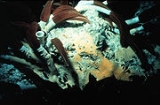
Giant tube worm
Overview
Giant tube worms, Riftia pachyptila, are marine
invertebrate
s in the phylum Annelid
a (formerly grouped in phylum Pogonophora
and Vestimentifera) related to tube worms commonly found in the intertidal and pelagic zone
s. Riftia pachyptila lives over a mile deep and up to several miles deep on the floor of the Pacific Ocean
near black smokers and can tolerate extremely high hydrogen sulfide
levels. They can reach a length of 2.4 metre.
They have a highly vascularized, red "plume" at the tip of their free end which is an organ for exchanging compounds with the environment (e.g., H2S
, CO2
, O2
, etc).
Ocean
An ocean is a major body of saline water, and a principal component of the hydrosphere. Approximately 71% of the Earth's surface is covered by ocean, a continuous body of water that is customarily divided into several principal oceans and smaller seas.More than half of this area is over 3,000...
invertebrate
Invertebrate
An invertebrate is an animal without a backbone. The group includes 97% of all animal species – all animals except those in the chordate subphylum Vertebrata .Invertebrates form a paraphyletic group...
s in the phylum Annelid
Annelid
The annelids , formally called Annelida , are a large phylum of segmented worms, with over 17,000 modern species including ragworms, earthworms and leeches...
a (formerly grouped in phylum Pogonophora
Pogonophora
There are two taxa with the name Pogonophora:*Pogonophora - an obsolete animal phylum, now treated as part of the family Siboglinidae*Pogonophora - a genus in the Euphorbiaceae...
and Vestimentifera) related to tube worms commonly found in the intertidal and pelagic zone
Pelagic zone
Any water in a sea or lake that is not close to the bottom or near to the shore can be said to be in the pelagic zone. The word pelagic comes from the Greek πέλαγος or pélagos, which means "open sea". The pelagic zone can be thought of in terms of an imaginary cylinder or water column that goes...
s. Riftia pachyptila lives over a mile deep and up to several miles deep on the floor of the Pacific Ocean
Pacific Ocean
The Pacific Ocean is the largest of the Earth's oceanic divisions. It extends from the Arctic in the north to the Southern Ocean in the south, bounded by Asia and Australia in the west, and the Americas in the east.At 165.2 million square kilometres in area, this largest division of the World...
near black smokers and can tolerate extremely high hydrogen sulfide
Hydrogen sulfide
Hydrogen sulfide is the chemical compound with the formula . It is a colorless, very poisonous, flammable gas with the characteristic foul odor of expired eggs perceptible at concentrations as low as 0.00047 parts per million...
levels. They can reach a length of 2.4 metre.
They have a highly vascularized, red "plume" at the tip of their free end which is an organ for exchanging compounds with the environment (e.g., H2S
Hydrogen sulfide
Hydrogen sulfide is the chemical compound with the formula . It is a colorless, very poisonous, flammable gas with the characteristic foul odor of expired eggs perceptible at concentrations as low as 0.00047 parts per million...
, CO2
Carbon dioxide
Carbon dioxide is a naturally occurring chemical compound composed of two oxygen atoms covalently bonded to a single carbon atom...
, O2
Oxygen
Oxygen is the element with atomic number 8 and represented by the symbol O. Its name derives from the Greek roots ὀξύς and -γενής , because at the time of naming, it was mistakenly thought that all acids required oxygen in their composition...
, etc).
Unanswered Questions
Discussions

